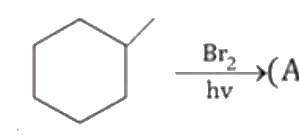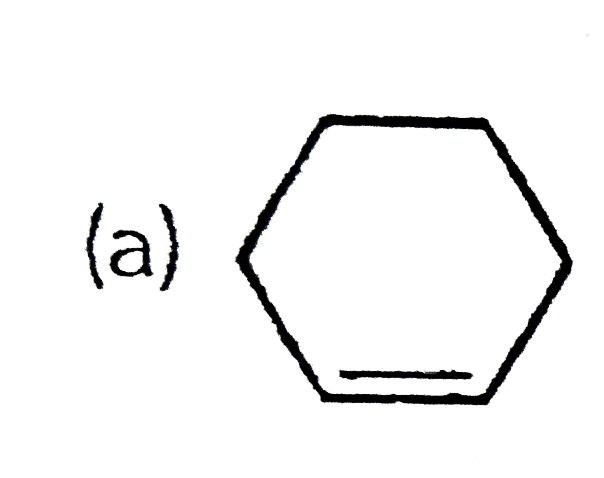CHCl3+MeCOMeOH−−−→Aexcess KOH−−−−−−→BNaOH−CaO−−−−−−−→CKOBr−−→D
MeCH2OH
MeCOOH
Me2CHOH
CH2Cl2
The correct Answer is:B
To solve the question step by step, we will analyze the reactions sequentially:
Step 1: Reaction of CHCl₃ with MeCOMe in the presence of OH⁻
- Starting Materials: CHCl₃ (chloroform) and MeCOMe (acetone).
- Reaction: When CHCl₃ is treated with a strong base like OH⁻, it undergoes deprotonation and forms a carbanion (CCl₃⁻). This carbanion can then attack the carbonyl carbon of acetone.
- Product A: The resulting product A will be a compound where the CCl₃ group is attached to the acetone structure. The product can be represented as:
A=CH3C(OH)(CCl3)H
Step 2: Reaction of A with excess KOH
- Starting Material: Product A.
- Reaction: Excess KOH will replace the chlorine atoms with hydroxyl groups (OH) due to nucleophilic substitution.
- Product B: The product after this reaction will have three hydroxyl groups, which is unstable, leading to the loss of a water molecule. The final product B will be:
B=CH3C(OH)3
This can further dehydrate to form a carboxylic acid, specifically acetic acid (CH₃COOH).
Step 3: Reaction of B with NaOH and CaO (Soda Lime)
- Starting Material: Product B (which is a carboxylic acid).
- Reaction: The combination of NaOH and CaO (soda lime) leads to decarboxylation, where the carboxyl group (-COOH) is removed as CO₂.
- Product C: After decarboxylation, we will obtain:
C=CH3CH3
This is propane.
Step 4: Reaction of C with KOBr
- Starting Material: Product C (propane).
- Reaction: The presence of KOBr will lead to a haloform reaction. In this reaction, the presence of the methyl group adjacent to a carbonyl will lead to the formation of a haloform (bromoform in this case).
- Product D: The final product D will be:
D=CH3CBr3
This is bromoform.
Final Summary
The final product D after all the reactions is bromoform (CHBr₃).
---
- Starting Materials: CHCl₃ (chloroform) and MeCOMe (acetone).
- Reaction: When CHCl₃ is treated with a strong base like OH⁻, it undergoes deprotonation and forms a carbanion (CCl₃⁻). This carbanion can then attack the carbonyl carbon of acetone.
- Product A: The resulting product A will be a compound where the CCl₃ group is attached to the acetone structure. The product can be represented as:
A=CH3C(OH)(CCl3)H
- Starting Material: Product A.
- Reaction: Excess KOH will replace the chlorine atoms with hydroxyl groups (OH) due to nucleophilic substitution.
- Product B: The product after this reaction will have three hydroxyl groups, which is unstable, leading to the loss of a water molecule. The final product B will be:
B=CH3C(OH)3
This can further dehydrate to form a carboxylic acid, specifically acetic acid (CH₃COOH).
- Starting Material: Product B (which is a carboxylic acid).
- Reaction: The combination of NaOH and CaO (soda lime) leads to decarboxylation, where the carboxyl group (-COOH) is removed as CO₂.
- Product C: After decarboxylation, we will obtain:
C=CH3CH3
This is propane.
- Starting Material: Product C (propane).
- Reaction: The presence of KOBr will lead to a haloform reaction. In this reaction, the presence of the methyl group adjacent to a carbonyl will lead to the formation of a haloform (bromoform in this case).
- Product D: The final product D will be:
D=CH3CBr3
This is bromoform.
The final product D after all the reactions is bromoform (CHBr₃).
Similar Questions
CH3CH=CH2NBS−−→AKCN−−→BOH−/Δ−−−−−→CP/Br2−−−→DNH3−−→EΔ−−→F
View SolutionCH3CHONH2−NH2−−−−−−→[A]KOH−−→[B]Br2/hv−−−−→[C]KOH(alc)−−−−−→[D]
Identify D
View Solution Br2−−→hv(A)alc. KOH−−−−→(B)OsO4−−→(C)HlO4−−→(D), Identify 'D'
Br2−−→hv(A)alc. KOH−−−−→(B)OsO4−−→(C)HlO4−−→(D), Identify 'D'
View SolutionThe product D of the reaction CH3ClKCN−−→(A)H2O−−→(B)NH3−−→(C)Δ−−→(D) is
View SolutionIn the following sequence of recation, identify the compounds (A), (B), (C ) and (D):
NSolutiona2CO3SO2−−→(A)Na2CO3−−−−→(B)S−−→Heat(C)AgNO3−−−→(D)
View SolutionIn the following identify the compounds/reaction conditions represented by the alphabets (A),(B), and (C) :
C6H5COOHPCl5−−→(A)NH3→(B)P2O5−−−→C6H5CNH2/Ni−−−−→(C).
View SolutionIn the decay process:
A−α−−→B−β−−→C−β−−→D
View SolutionIdentify A to G in the following.
(a) Br2,CCl4−−−−−→AKCN−−→BH3O+−−−→C
Br2,CCl4−−−−−→AKCN−−→BH3O+−−−→C
(b) Br2,CCl4−−−−−→DKCN−−→EH3O+−−−→G
Br2,CCl4−−−−−→DKCN−−→EH3O+−−−→G
View SolutionCH3CH2CH2OHPBr5−−→(A)KOH(Alc)−−−−−−→(B)HBr−−→(C)NH3−−→(D)
Identify the product
View SolutionIdentify the following:
Na2CO3So2−−→ANa2CO3−−−−→BElement s−−−−−→ΔCI2−−→D
Also mention the oxidation state of S in all the compounds.
View Solution
